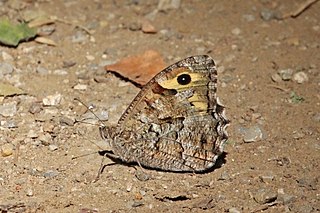
Hipparchia is a genus of butterflies within the family Nymphalidae. The genus was erected by Johan Christian Fabricius in 1807.
Hipparchia azorina, the Azores grayling, is a species of butterfly in the family Nymphalidae. It is endemic to the Azores. Its natural habitats are temperate forests and temperate grassland. It is threatened by habitat loss.

Hipparchia maderensis, the Madeiran grayling, is a species of butterfly in the family Nymphalidae. It is endemic to Madeira. Its natural habitat is temperate forests. Seitz treats it as a race of Hipparchia semele - in maderensis Baker, from Madeira the upperside in both sexes is strongly obscured and in the male almost without any markings.

Hipparchia fatua, or Freyer's grayling, is a butterfly of the family Nymphalidae. The species can be found from the Balkans, through Anatolia up to Iran.

Hipparchia hermione, the rock grayling, is a butterfly of the family Nymphalidae. The species can be found in Central Europe, Southern Europe, Eastern Europe, North Africa, Anatolia and the Caucasus.

Caradrina kadenii, or Clancy's rustic, is a moth of the family Noctuidae. The species was first described by Christian Friedrich Freyer in 1836. It originates from southern and central Europe, Asia Minor and southern Russia but in the 21st century it has extended its range to the north.
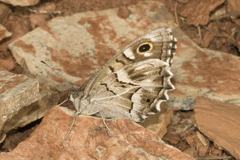
Hipparchia fidia, the striped grayling, is a butterfly of the family Nymphalidae. It is found on the Iberian Peninsula, the Balearic Islands and in south-eastern France and the bordering parts of Italy and North Africa.

Aricia cramera, the southern brown argus, is a butterfly of the family Lycaenidae. It is a butterfly of Southern Europe and North Africa and can be found from Morocco and Tunisia up to Spain and Portugal, on Mediterranean islands including Menorca and on the Canary Islands.

Euxoa aquilina is a moth of the family Noctuidae. It is found in the Mediterranean region of Europe, North Africa, the Near East and the Middle East.

Hipparchia syriaca is a species of butterfly in the family Nymphalidae. It is found in Greece especially on the island of Samos, Turkey, Bulgaria, Albania, North Macedonia, Caucasus and Transcaucasia. It is found on the edges of foothills and mountain forests up to 2,000 m

Hipparchia neomiris, the Corsican grayling, is a butterfly in the family Nymphalidae. It is an endemic species confined to the islands of Corsica, Sardinia and Elba. The Corsican grayling flies in July.

Coenonympha corinna, the Corsican heath, is a butterfly in the family Nymphalidae

Hyponephele lupina, the Oriental meadow brown or branded meadowbrown, is a butterfly of the family Nymphalidae. It is found in North Africa, south western Europe, southern Russia, Asia Minor, southern Siberia, Middle Asia, Iran and from Baluchistan to Nepal.Seitz describes it thus- lupinus Costa is rather considerably larger than the forms [of Epinepele] so far named; the rusty yellow on the underside of the forewing is brighter, the underside of the hindwing strongly speckled. Southern Italy, Greece.
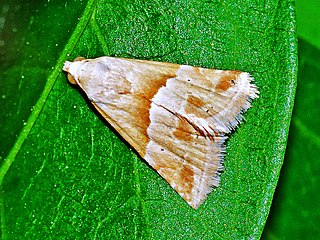
Eublemma parva, the small marbled, is a moth of the family Erebidae. The species was first described by Jacob Hübner in 1808.
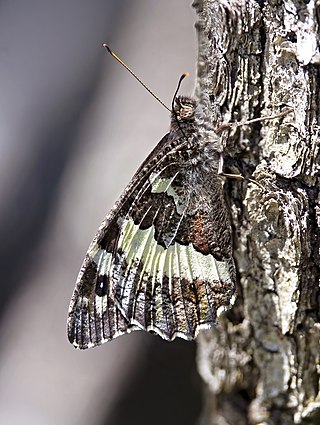
Brintesia is a monotypic butterfly genus in the family Nymphalidae and subfamily Satyrinae. Its one species is Brintesia circe, the great banded grayling.

Fabriciana elisa, the Corsican fritillary, is a butterfly of the family Nymphalidae. It is found in Corsica and Sardinia. This is a mountain butterfly, found on grassy vegetation in clearings in deciduous woods.

The Sardinian meadow brown is a butterfly belonging to the family Nymphalidae. It is a small butterfly with orange and brown colouring. The butterfly is only found in Sardinia. Seitz describes it thus E. nurag Ghil.. Considerably smaller than the jurtina-forms, otherwise closely allied to them. Both sexes with an ochre-yellow distal band, which in the male is sometimes reduced to an interrupted half-band of the forewing, but usually, as always in the female, continues through both the wings; the ground colour a very pale brown. The underside of the hindwing greyish brown, with a sometimes obsolete, mostly but slightly prominent median band. — In Sardinia and Corsica, in June and July, very local, apparently only flying in localities of a certain definite character which are covered with hard grasses.
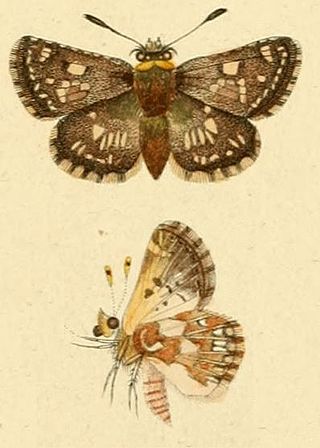
Spialia therapne, the Corsican red-underwing skipper, is a butterfly in the family Hesperiidae. It is found on the Mediterranean islands of Corsica and Sardinia.

Aglais ichnusa is a small butterfly found in the Palearctic that belongs to the browns family. It is endemic to Corsica and Sardinia.




















